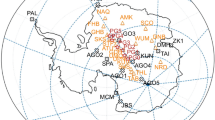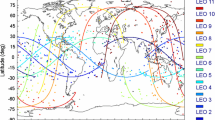Abstract
Low-earth-orbit (LEO) spacecraft formation flying (SFF) simulated on the Virginia Tech Formation Flying Testbed (VTFFTB) demonstrated the feasibility of detecting simplified ionospheric electron density (Ne) structures (i.e., one-dimensional equatorial plasma bubbles/EPBs) utilizing a differential total electron content (TEC) method. The Thermosphere-Ionosphere-Electrodynamics General Circulation Model (TIEGCM) is used to greatly enhance the ionospheric Ne simulation capability and fidelity (e.g., dimension, resolution, more realistic space weather processes) of GNSS-based hardware-in-the-loop (HIL) simulations in the current work. An algorithm is developed to incorporate TIEGCM 4D ionospheric Ne profiles into the VTFFTB HIL infrastructure by simulating the TEC impacts on multi-band GNSS signals. First, a series of first-principle analyses on ionospheric Ne retrieval accuracy are presented using software-based LEO SFF simulations in the TIEGCM ionosphere. Subsequently, two HIL ionospheric space weather observation simulation test cases, EPB and Tongues-of-Ionization (TOI), are simulated on the VTFFTB to demonstrate the enhanced 4D ionospheric simulation capability and evaluate the Ne retrieval characteristics. The Ne retrieval techniques are validated and characterized in the TIEGCM ionosphere via both software and HIL simulations. In principle, the technique developed is expected to be applicable to other similar simulation platforms, as well as other global or regional ionospheric models. This is advantageous for future GNSS testing, HIL simulations, and technology developments.



















Similar content being viewed by others
Data availability
The TIEGCM dataset (a) and (b) in “.mat” format are archived in “https://computing.ece.vt.edu/~TIEGCM/”. For source codes to implement the algorithms in the VTFFTB, please contact the authors to discuss options.
References
CANX-4 and 5 mission. http://www.utias-sfl.net/?page_id=410
Coster A, Foster JC (2007) Space-weather impacts of the sub-auroral polarization stream. URSI Radio Sci Bull 321:28–36. https://doi.org/10.23919/URSIRSB.2007.7909676
Coster A, Komjathy A (2008) Space weather and the global positioning system. Space Weather. https://doi.org/10.1029/2008SW000400
Deshpande K, Bust G, Clauer CR, Scales W, Frissell N, Ruohoniemi JM, Spogli L, Mitchell C, Weatherwax A (2016) Satellite-beacon ionospheric-scintillation global model of the upper atmosphere (sigma) II: inverse modeling with high-latitude observations to deduce irregularity physics. J Geophys Res Space Phys 121(9):9188–9203
Foster JC, Burke W (2002) SAPS: a new categorization for sub-auroral electric fields. Eos Trans Am Geophysl Union 83(36):393–394
Foster JC et al (2005) Multiradar observations of the polar tongue of ionization. J Geophy Res Space Phys. https://doi.org/10.1029/2004JA010928
Huang C, Beaujardiere O, Roddy A, Hunton D, Pfaff R, Valladares C, Ballenthin J (2011) Evolution of equatorial ionospheric plasma bubbles and formation of broad plasma depletions measured by the c/nofs satellite during deep solar minimum. J Geophys Res Space Phys. https://doi.org/10.1029/2010JA015982
Huba JD, Joyce G (2010) Global modeling of equatorial plasma bubbles. Geophys Res Lett 37:17. https://doi.org/10.1029/2010GL044281
Huba JD, Joyce G, Krall J (2008) Three-dimensional equatorial spread F modeling. Geophys Res Lett 35:10
Huba JD, Liu HL (2020) Global modeling of equatorial spread F with SAMI3/WACCM-X. Geophys Res Lett 47:14. https://doi.org/10.1029/2020GL088258
Hosokawa K, Tsugawa T, Shiokawa K, Otsuka Y, Nishitani N, Ogawa T, Hairston M (2010) Dynamic temporal evolution of polar cap tongue of ionization during magnetic storm. J Geophy Res Space Phys. https://doi.org/10.1029/2010JA015848
Jayawardena T, Buesnel G, Mitchell C, Boyles R, Forte B, Watson R (2017) Towards re-creating real-world ionospheric scintillation events in a spirent simulator-based robust pnt test framework. Proceedings of the ION ITM, Institute of Navigation, Monterey, California, USA, pp 1024–1032. https://doi.org/10.33012/2017.14947
Kelley MC (1989) The earth’s ionosphere: plasma physics and electrodynamics, vol 487. Academic, San Diego, California
Kotova DS, Klimenko MV, Klimenko VV, Zakharov VE, Ratovsky KG, Nosikov IA, Zhao B (2015) Using IRI and GSM TIP model results as environment for HF radio wave propagation model during the geomagnetic storm occurred on September 26–29, 2011. Adv Space Res 56(9):2012–2029. https://doi.org/10.1016/j.asr.2015.05.009
Lin D, Wang W, Scales W, Pham K, Liu J, Zhang B, Merkin V, Shi X, Kunduri B, Maimaiti M (2019) SAPS in the 17 March 2013 storm event: initial results from the coupled magnetosphere-ionosphere-thermosphere model. J Geophys Res Space Phys 124(7):6212–6225
Peng Y, Scales W (2019) Satellite formation flight simulation using multi-constellation GNSS and applications to ionospheric remote sensing. Remote Sens 11(23):2851. https://doi.org/10.3390/rs11232851
Peng Y, Scales W, Edwards T (2020) GPS-based satellite formation flight simulation and applications to ionospheric remote sensing. Navigation 67(1):3–21. https://doi.org/10.1002/navi.354
Peng Y, Scales W, Esswein M, Hartinger M (2019) Small satellite formation flying simulation with multi-constellation GNSS and applications to future multi-scale space weather observations. Proceedings of the ION GNSS+, Institute of Navigation, Miami, Florida, USA, pp 2035–2047. https://doi.org/10.33012/2019.16883
Rawer K, Bilitza D, Ramakrishnan S (1978) Goals and status of the international reference ionosphere. Rev Geophys 16(2):177–181
Roble R, Ridley E, Richmond A, Dickinson R (1988) A coupled thermosphere/ionosphere general circulation model. Geophys Res Lett 15(12):1325–1328
Spirent Communications plc. (2012) SimGen Software User Manual. DGP00686AAA, 4-02 SR02
Spirent Communications plc. (2012) SimRemote User Manual and ICD. DGP00792AAA
Smith J, Heelis R (2017) Equatorial plasma bubbles: variations of occurrence and spatial scale in local time, longitude, season, and solar activity. J Geophys Res Space Phys 122(5):5743–5755
Zawdie KA, Drob DP, Huba JD, Coker C (2016) Effect of time-dependent 3-D electron density gradients on high angle of incidence HF radiowave propagation. Radio Sci 51(7):1131–1141. https://doi.org/10.1002/2015RS005843
Acknowledgements
The authors would like to appreciate Talini Pinto Jayawardena, Paul Crampton and Edward Schwanke from Spirent for providing useful suggestions. Thanks also go to Sreeja Veettil from the University of Nottingham for sharing valuable experience. Dong Lin is supported by the Advanced Study Program (ASP) Postdoctoral Fellowship of the National Center for Atmospheric Research (NCAR). NCAR is sponsored by the National Science Foundation (NSF).
Author information
Authors and Affiliations
Corresponding author
Additional information
Publisher's Note
Springer Nature remains neutral with regard to jurisdictional claims in published maps and institutional affiliations.
Supplementary information
ESM1 (AVI 18204 kb)
ESM1 (AVI 15874 kb)
ESM1 (AVI 22448 kb)
ESM1 (AVI 21615 kb)
ESM1 (AVI 18517 kb)
Rights and permissions
About this article
Cite this article
Peng, Y., Scales, W.A. & Lin, D. GNSS-based hardware-in-the-loop simulations of spacecraft formation flying with the global ionospheric model TIEGCM. GPS Solut 25, 65 (2021). https://doi.org/10.1007/s10291-021-01099-x
Received:
Accepted:
Published:
DOI: https://doi.org/10.1007/s10291-021-01099-x




